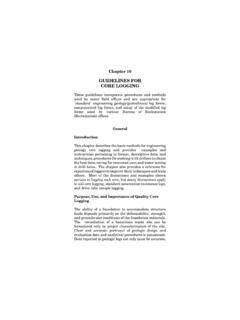Laboratory Testing And Interpretation Of Rock Properties
Found 5 free book(s)CHAPTER 6
www.dot.ny.govThe detailed measurement and interpretation of soil and rock properties shall be consistent with the guidelines provided in FHWA-IF-02-034, Evaluation of Soil and Rock Properties, Geotechnical Engineering Circular No. 5 (Sabatini, et al., 2002), except as specifically indicated herein. 6.4 GEOTECHNICAL LABORATORY SERVICES
Timber Pile Design and Construction Manual
www.piledrivers.org12.5.2 Rock Core Samplers 12.6 Groundwater Conditions 12.7 Subsurface Profile Development 12.8 In-Situ Testing 12.8.1 Cone Penetration Test (CPT) 12.8.2 Vane Shear Test 12.9 Laboratory Soil Testing 12.9.1 Index Tests 12.9.2 Shear Strength Tests 12.9.3 Consolidation Tests 12.10 Laboratory Testing for Pile Driveability Determination References
In situ testing - geotechnique.info
www.geotechnique.infolaboratory testing offers the best method of determining soil and rock parameters under carefully controlled conditions. Sampling techniques have already been described in Chapters 6 and 7 and laboratory testing techniques in Chapter 8. But other types of ground are either difficult or impossible to sample and test successfully.
[THIS PAGE IS INTENTIONALLY LEFT BLANK]
www.dot.state.pa.us15.3 identifying slaking rock ..... 15-5 15.4 slake testing methods, results and interpretation ..... 15-11 15.5 foundation design guidelines for slaking rock ..... 15-17 . appendix a – instrumentation field (in-situ) testing appendix b –
GUIDELINES FOR CORE LOGGING
people.uncw.eduDetailed microscopic or laboratory testing to define rock type or mineralogy generally are necessary only in special cases. Empirical design methods, such as the Rock Mass Rating System Geomechanics Classification (RMR) and Q-system Classification (Q), are commonly used for design of under-ground structures and are coming into common use for



![[THIS PAGE IS INTENTIONALLY LEFT BLANK]](/cache/preview/1/3/b/d/8/d/d/4/thumb-13bd8dd4570a5e462f8fb7a7042a0f0f.jpg)
